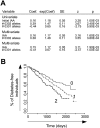Impact of diabetes susceptibility loci on progression from pre-diabetes to diabetes in at-risk individuals of the diabetes prevention trial-type 1 (DPT-1)
- PMID: 18556337
- PMCID: PMC2518486
- DOI: 10.2337/db07-1736
Impact of diabetes susceptibility loci on progression from pre-diabetes to diabetes in at-risk individuals of the diabetes prevention trial-type 1 (DPT-1)
Abstract
Objective: The unfolding of type 1 diabetes involves a number of steps: defective immunological tolerance, priming of anti-islet autoimmunity, and destruction of insulin-producing beta-cells. A number of genetic loci contribute to susceptibility to type 1 diabetes, but it is unclear which stages of the disease are influenced by the different loci. Here, we analyzed the frequency of type 1 diabetes-risk alleles among individuals from the Diabetes Prevention Trial-Type 1 (DPT-1) clinical trial, which tested a preventive effect of insulin in at-risk relatives of diabetic individuals, all of which presented with autoimmune manifestations but only one-third of which eventually progressed to diabetes.
Research design and methods: In this study, 708 individuals randomized into DPT-1 were genotyped for 37 single nucleotide polymorphisms in diabetes susceptibility loci.
Results: Susceptibility alleles at loci expected to influence immunoregulation (PTPN22, CTLA4, and IL2RA) did not differ between progressors and nonprogressors but were elevated in both groups relative to general population frequencies, as was the INS promoter variant. In contrast, HLA DQB1*0302 and DQB1*0301 differed significantly in progressors versus nonprogressors (DQB*0302, 42.6 vs. 34.7%, P = 0.0047; DQB*0301, 8.6 vs. 14.3%, P = 0.0026). Multivariate analysis of the factors contributing to progression demonstrated that initial titers of anti-insulin autoantibodies (IAAs) could account for some (P = 0.0016) but not all of this effect on progression (P = 0.00038 for the independent effect of the number of DQB*0302 alleles). The INS-23 genotype was most strongly associated with anti-IAAs (median IAA levels in TT individuals, 60 nU/ml; AT, 121; and AA, 192; P = 0.000037) and only suggestively to the outcome of oral insulin administration.
Conclusions: With the exception of HLA, most susceptibility loci tested condition the risk of autoimmunity rather than the risk of failed immunoregulation that results in islet destruction. Future clinical trials might consider genotyping INS-23 in addition to HLA alleles as disease/treatment response modifier.
Figures




References
-
- Eisenbarth GS: Update in type 1 diabetes. J Clin Endocrinol Metab 92 :2403 –2407,2007 - PubMed
-
- Maier LM, Wicker LS: Genetic susceptibility to type 1 diabetes. Curr Opin Immunol 17 :601 –608,2005 - PubMed
-
- Vafiadis P, Bennett ST, Todd JA, Nadeau J, Grabs R, Goodyer CG, Wickramasinghe S, Colle E, Polychronakos C: Insulin expression in human thymus is modulated by INS VNTR alleles at the IDDM2 locus. Nat Genet 15 :289 –292,1997 - PubMed
-
- Pugliese A, Zeller M, Fernandez A Jr, Zalcberg LJ, Bartlett RJ, Ricordi C, Pietropaolo M, Eisenbarth GS, Bennett ST, Patel DD: The insulin gene is transcribed in the human thymus and transcription levels correlated with allelic variation at the INS VNTR-IDDM2 susceptibility locus for type 1 diabetes. Nat Genet 15 :293 –297,1997 - PubMed
-
- Bottini N, Musumeci L, Alonso A, Rahmouni S, Nika K, Rostamkhani M, MacMurray J, Meloni GF, Lucarelli P, Pellecchia M, Eisenbarth GS, Comings D, Mustelin T: A functional variant of lymphoid tyrosine phosphatase is associated with type I diabetes. Nat Genet 36 :337 –338,2004 - PubMed
Publication types
MeSH terms
Substances
Grants and funding
LinkOut - more resources
Full Text Sources
Medical
Research Materials

